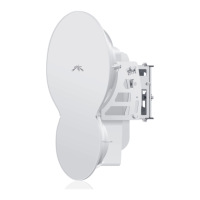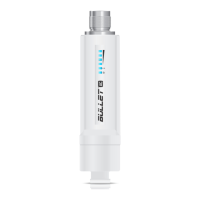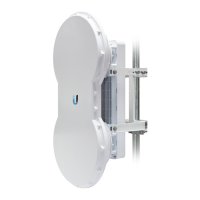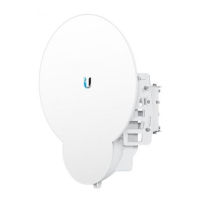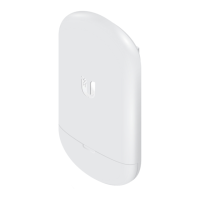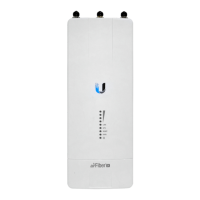Do you have a question about the Ubiquiti AF-5X and is the answer not in the manual?
Step-by-step guide for connecting AF-5X to power using PoE and Ethernet.
Accessing the interface and setting up basic wireless mode and frequency.
Setting the operating frequency, ensuring Master/Slave match.
Configuring wireless security using HEX or ASCII key types.
Instructions for properly grounding the AF-5X unit for safety.
Step-by-step guide for mounting AF-5X onto an airFiber X antenna or RocketDish.
Connecting RF cables from antenna feed to AF-5X chains.
Recommendations for surge protectors to prevent electrical damage.
Advice for accurate radio alignment for best performance.
Steps to align Master and Slave units to establish a stable RF link.
How to access the AF-5X Configuration Interface via a web browser.
Details login screen, credentials, and agreeing to terms of use.
Configuring mode, link name, country code, bandwidth, and output power.
Clarifies the role of Master and Slave modes for PtP links.
Importance of consistent link names and correct country code for compliance.
Settings for channel bandwidth size and Master's transmit duty cycle.
Configuring transmit power and antenna gain, noting DFS impact.
Setting modulation rate, including auto adaptation or manual selection.
Configuring operating frequencies and understanding DFS options.
Setting up wireless security using AES encryption with HEX or ASCII keys.
Configuration of network settings for device management, including IP addresses.
Options for setting Management IP Address via DHCP or Static assignment.
Advanced configurations for DATA port: speed, flow control, multicast filter.
Details on Track Radio Link, Link Off Duration, and Spacing for RF link loss.
Setting up Ping Watchdog for connectivity monitoring and auto-reboot.
Managing firmware updates, checking for versions, and uploading files.
Managing administrator and read-only accounts and passwords for security.
Step-by-step guide for connecting AF-5X to power using PoE and Ethernet.
Accessing the interface and setting up basic wireless mode and frequency.
Setting the operating frequency, ensuring Master/Slave match.
Configuring wireless security using HEX or ASCII key types.
Instructions for properly grounding the AF-5X unit for safety.
Step-by-step guide for mounting AF-5X onto an airFiber X antenna or RocketDish.
Connecting RF cables from antenna feed to AF-5X chains.
Recommendations for surge protectors to prevent electrical damage.
Advice for accurate radio alignment for best performance.
Steps to align Master and Slave units to establish a stable RF link.
How to access the AF-5X Configuration Interface via a web browser.
Details login screen, credentials, and agreeing to terms of use.
Configuring mode, link name, country code, bandwidth, and output power.
Clarifies the role of Master and Slave modes for PtP links.
Importance of consistent link names and correct country code for compliance.
Settings for channel bandwidth size and Master's transmit duty cycle.
Configuring transmit power and antenna gain, noting DFS impact.
Setting modulation rate, including auto adaptation or manual selection.
Configuring operating frequencies and understanding DFS options.
Setting up wireless security using AES encryption with HEX or ASCII keys.
Configuration of network settings for device management, including IP addresses.
Options for setting Management IP Address via DHCP or Static assignment.
Advanced configurations for DATA port: speed, flow control, multicast filter.
Details on Track Radio Link, Link Off Duration, and Spacing for RF link loss.
Setting up Ping Watchdog for connectivity monitoring and auto-reboot.
Managing firmware updates, checking for versions, and uploading files.
Managing administrator and read-only accounts and passwords for security.
| Frequency Range | 5.1 - 5.9 GHz |
|---|---|
| Max Range | 100+ km |
| Max. Power Consumption | 10W |
| Power Method | Passive PoE |
| Wireless Approvals | FCC, IC, CE |
| RoHS Compliance | Yes |
| Ethernet | 1 x 10/100/1000 Mbps |
| Wind Survivability | 200 km/h |
| Power Supply | 24V, 1A PoE |
| Enclosure Characteristics | Outdoor |
| Max. Conducted TX Power | 27 dBm |
| Channel Bandwidth | 20/40 MHz |
| Operating Temperature | -40 to 70 °C |
| Operating Humidity | 5 to 95% Non-condensing |
| Polarization | Dual Linear |

